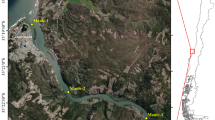Abstract
A multi-pond saltern that creates a gradient of salt concentrations has been studied with respect to some characteristics of the resulting environments and their microbial populations. The increase in salt concentration was correlated with increase in diurnal temperature and biomass present and with decrease in oxygen concentrations. Many types of organisms below 15% (w/v) total salts, were found, many of them normal inhabitants of seawater and even freshwater. Most organisms over 15% salts were halophilic. The salt concentrations comprised two ranges, each characterized by different microbial populations. First, between 15 and 30% salts, the populations ofDunaliella increased, reaching large numbers; moderately halophilic eubacteria and some fast-growing halobacteria predominated as heterotrophic microorganisms and, among the first, thePseudomonas-Alteromonas-Alcaligenes group andVibrio were the more abundant taxonomic groups; and gram-positive cocci appeared mainly over 25% salts. Phototrophic bacteria, both oxygenic and anoxygenic, were also found in this range, and among the anoxygenic type,Chromatium species andRodospirillum salexigens were probably predominant. Second, over 30% salts the diversity decreased greatly, all organisms found at the lower salt concentrations disappeared, and instead large populations of halobacteria developed. Over 50% salts, only three species of halobacteria were found.
Similar content being viewed by others
References
American Public Health Association (1980) Standard methods for the examination of water and wastewater. Washington, D.C.
Biebl H, Drews G (1969) Das in-vivo-Spektrum als taxonomisches Merkmal bei der Untersuchung zur Verbreitung von Athiorhodaceae. Zbl. Bakteriol. Parasitenk II Abt 123:425–452
Brock TD (1978) Thermophilic microorganisms and life at high temperatures. Springer-Verlag, New York
Brock TD (1979) Ecology of saline lakes. In: Shilo M (ed) Strategies of microbial life in extreme environments. Verlag-Chemie, Weinheim, pp 29–47
Brown AD, Borowitzka LJ (1979) Halotolerance ofDunaliella. In: Levandowsky M, Hutner SH (eds) Biochemistry and physiology of protozoa, vol. 1. Academic Press, New York, pp 139–190
Drews G (1981)Rhodospirillum salexigens, spec. nov., an obligatory halophilic phototrophic bacterium. Arch Microbiol 130:325–327
Imhoff JF, Tindall BJ, Grant WD, Trüper HG (1981)Ectothiorhodospira vacuolata sp. nov., a new phototrophic bacterium. Arch Microbiol 130:238–242
Imhoff JF, Trüper HG (1977)Ectothiorhodospira halochloris sp. nov., a new extremely halophilic phototrophic bacterium containing bacteriochlorophyll b. Arch Microbiol 114: 115–121
Imhoff JF, Trüper HG (1981)Ectothiorhodospira abdelmalekii sp. nov., a new halophilic and alkaliphilic phototrophic bacterium. Zbl Bakt Hyg I abt Orig C2:228–234
Javor B, Requadt C, Stoeckenius W (1982) Box-shaped halophilic bacteria. J Bacteriol 151:1532–1542
Kushner DJ (1978) Life in high salt and solute concentrations: halophilic bacteria. In: Kushner DJ (ed) Microbial life in extreme environments. Academic Press, New York, pp 318–358
Mullakhanbhai MF, Larsen H (1975)Halobacterium volcanii spec. nov., a Dead Sea halobacterium with a moderate salt requirement. Arch Microbiol 104:207–214
Oren A (1983)Halobacterium sodomense sp. nov., a Dead Sea halobacterium with an extremely high magnesium requirement. Int J Syst Bacteriol 33:381–386
Quesada E, Ventosa A, Rodriguez-Valera F, Megias L, Ramos-Cormenzana A (1983) Numerical taxonomy of moderately halophilic gram-negative bacteria from hypersaline soils. J Gen Microbiol 129:2649–2657
Raymond JC, Sistrom WR (1969)Ectothiorhodospira halophila: a new species of the genusEctothiorhodospira. Arch Microbiol 69:121–126
Rodriguez-Valera F, Juez G, Kushner DJ (1983)Halobacterium mediterranei spec. nov., a new carbohydrate-utilizing extreme halophile. System Appl Microbiol 4:369–381
Rodriguez-Valera F, Ruiz-Berraquero F, Ramos-Cormenzana A (1981) Characteristics of the heterotrophic bacterial populations in hypersaline environments of different salt concentrations. Microb Ecol 7:235–243
Strickland DM, Parsons TR (1972) A practical handbook of seawater analyses. Department of Fisheries and the Environment Fisheries and Marine Service, Scientific Information and Publications Branch, Ottawa
Subow NN (1931) Oceanographical tables. USSR Ocean Inst Hydrometeor Comm, Moscow
Ventosa A, Quesada E, Rodriguez-Valera F, Ruiz-Berraquero F, Ramos-Cormenzana A (1982) Numerical taxonomy of moderately halophilic gram-negative rods. J Gen Microbiol 128:1959–1969
Woese CR, Magrum LJ, Fox GE (1978) Archaebacteria. J Mol Evol 11:245–252
Yopp JH, Tindall DR, Miller DM, Schmid WE (1978) Isolation, purification and evidence for a halophilic nature of the blue-green algaAphonothece halophitica Fremy (Chroococcales). Phycologia 17:172–178.
Author information
Authors and Affiliations
Rights and permissions
About this article
Cite this article
Rodriguez-Valera, F., Ventosa, A., Juez, G. et al. Variation of environmental features and microbial populations with salt concentrations in a multi-pond saltern. Microb Ecol 11, 107–115 (1985). https://doi.org/10.1007/BF02010483
Issue Date:
DOI: https://doi.org/10.1007/BF02010483




